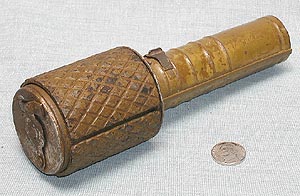 Ruchnaya Granata Degtyareva
Ruchnaya Granata Degtyareva ("Hand Grenade of the Degtyarev design")
Model 1933 used during WWII and after, thru Vietnam.
Sheet metal construction, with a removable outer fragmentation sleeve. Time delay fuze with a cocked striker, activated when thrown, utilizing a unique mechanical system.
A most complex grenade design.
The RGD-33 was the next generation replacement to the W.W.I. Model 1914/30 stick grenade, which also had a released igniter fuze mechanism.
As a collectable, the functional mechanics of this design cannot be displayed without making a cut-away, as the parts are all crimped shut when manufactured. Hopefully this presentation will provide interesting details!
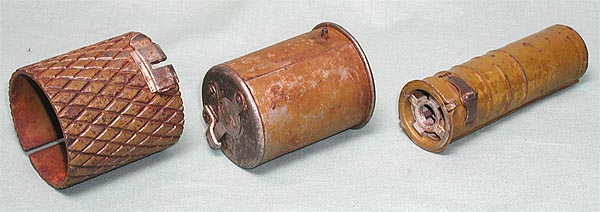
|
The grenade body (a.k.a. "Head" or "Pot") contained all the explosive elements, as well as a coiled and segmented internal fragmentation belt. It is a sealed unit, crimped at the base.
The top hatch rotates to open a central tube where the fuze/detonator was inserted.
The removable fragmentation sleeve was used as required for defensive purposes.
The fuze/detonator assembly, body and handle were packaged and transported separately.
The handle consists of two major assemblies, an internal handle tube with an cam insert, and an external handle holding the firing pin clip. A strong coiled spring joins the two, pulling them together.
Deployment in the Field:
o The grenade body and handle assembly are screwed together, tight.
o The external thumb safety switch is moved to the right. This locks the handle assembly.
o Assembled grenades were carried in canvas pouches. Fuzes were placed in a special pocket, each in a paper or cloth wrapper and only inserted into the grenade immediately before use.
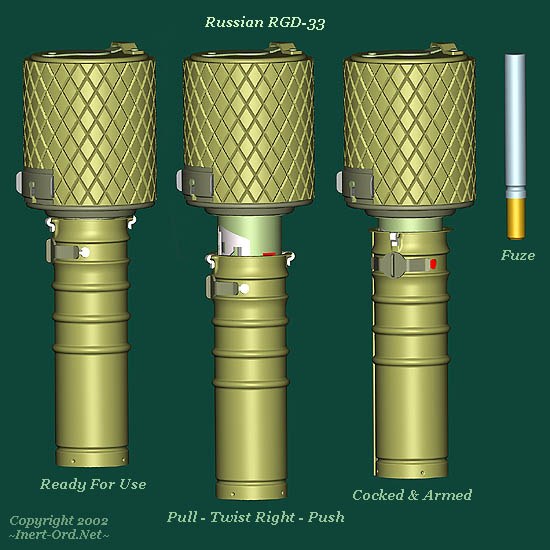
o The thumb safety is moved left, unlocking the inner and outer handles.
o While holding the head, the outer handle is pulled back, twisted clock-wise and pushed forward.
This cocks the mechanism, indicated by a red indicator to the right of the thumb safety.
(Only the outer handle moves, the inner tube is held tight to the head by a locking washer.)
o The thumb safety is pushed right so that the red dot is covered. The handle is now cocked and locked.
o The fuze/detonator is inserted from the top, pressed in against an internal spring lever (Fuze Safety).
The top cover is rotated and closed over the fuze.

(Above Left) - The grenade, ready for use, as carried in the pouch.
Note the Fuze Safety blocking the fuze well opening. This prevents the fuze/detonator from being prematurely
inserted, contacting the firing pin and firing. The firing pin clip is guided by the "J" shaped cut in the insert.
(Above right) - Only when the handle is cocked can the fuze be fully inserted. The spring loaded Fuze Safety is pushed aside as the fuze capsule emerges, allowing the fuze to be seated fully and the top cover to be closed. If the grenade is to be dis-armed, the safety pushes the fuze back out when the top cover is opened.
(Above right) - Only when the handle is cocked can the fuze be fully inserted. The spring loaded Fuze Safety is pushed aside as the fuze capsule emerges, allowing the fuze to be seated fully and the top cover to be closed. If the grenade is to be dis-armed, the safety pushes the fuze back out when the top cover is opened.
Operation:
o The thumb safety is moved to the left, exposing the red dot.
o A crisp and rapid throwing motion is required to activate the mechanism.
When thrown, the grenade head shifts relative to the outer handle and frees the firing pin clip from the small notch in the internal insert. The forward momentum of the head, aided by the handle spring, twists and pulls the firing pin clip back until it reaches the long slot, then is snapped forward, pulled by that same spring, forcing the firing pin into the primer, starting the fuze delay.
About 3-½ seconds later the grenade explodes.
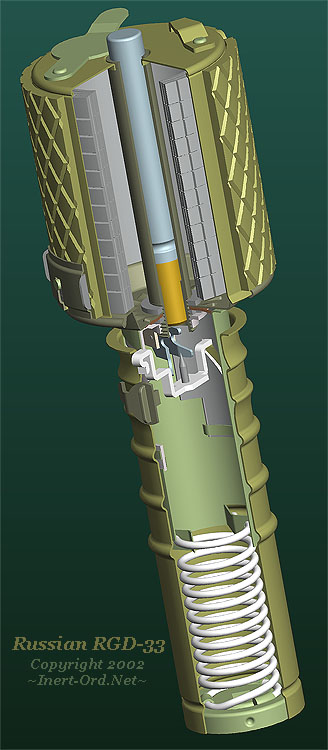
While examining the two grenade examples available for this page, it seems this hand grenade can be found with both left and right twist springs. (Curious detail)
The cut-away shows a right-hand twist design. Turn the handle clock-wise and you push against the spring. A left hand twist would pull the spring.
The type can be identified by looking at the base of the handle. The picture below shows a left twist and a right twist handle. Note that even the sheet metal seams are reversed!
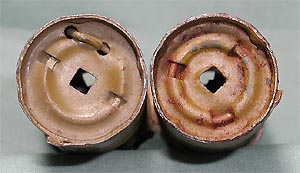
Here are manufacturer's markings found on the handles and heads. Anyone know what they mean or can supply a reference for them?
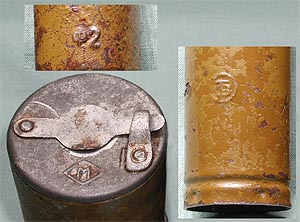
One final curious historical footnote about the RGD-33 Hand Grenade...
Former Russian Prime Minister BorisYeltsin, when he was 11 years old during WWII, blew off the thumb and forefinger of his left hand while disassembling a type RGD-33 that he and friends had stolen from a weapons
warehouse.
(Found this on the web somewhere... anyone know if it is true?)